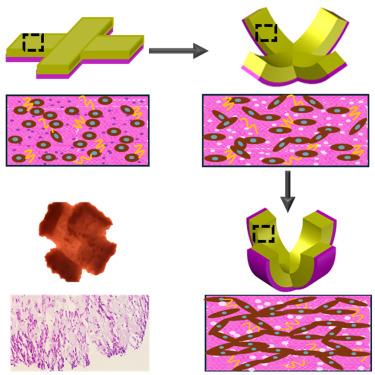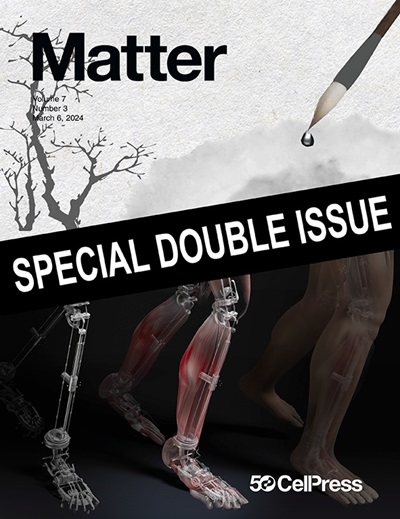细胞收缩力驱动4D生物打印活体结构的时空形态发生
IF 17.5
1区 材料科学
Q1 MATERIALS SCIENCE, MULTIDISCIPLINARY
引用次数: 0
摘要
目前的4D材料通常依赖于外部刺激,如热或光来完成形状的改变,这限制了这些材料的生物相容性。在这里,由氧化和甲基丙烯酸化海藻酸盐(OMA),甲基丙烯酸化明胶(GelMA)和明胶微球组成的复合生物链接被开发出来,以完成由内部刺激驱动的细胞负载结构的独立4D生物打印:细胞收缩力(CCFs)。形状的4D变化是通过形成由一个无细胞层和一个有细胞层组成的双层结构来指导的。人间充质干细胞(hMSCs)被包裹,以证明同时诱导形状变化和软骨/成骨分化的能力。最后,展示了对打印结构的每层进行图像化以获得复杂几何变化的能力,包括围绕两个独立的非平行轴弯曲。CCFs介导的这种4D构建体的生物打印可以形成更复杂的构建体,有助于更大程度的生物4D现象的体外仿生学。本文章由计算机程序翻译,如有差异,请以英文原文为准。

Cell contractile forces drive spatiotemporal morphogenesis in 4D bioprinted living constructs
Current 4D materials typically rely on external stimuli such as heat or light to accomplish changes in shape, limiting the biocompatibility of these materials. Here, a composite bioink consisting of oxidized and methacrylated alginate (OMA), methacrylated gelatin (GelMA), and gelatin microspheres is developed to accomplish freestanding 4D bioprinting of cell-laden structures driven by an internal stimulus: cell contractile forces (CCFs). 4D changes in shape are directed by forming bilayer constructs consisting of one cell-free and one cell-laden layer. Human mesenchymal stem cells (hMSCs) are encapsulated to demonstrate the ability to simultaneously induce changes in shape and chondrogenic/osteogenic differentiation. Finally, the capability of patterning each layer of the printed constructs to obtain complex geometric changes—including bending around two separate, non-parallel axes—is exhibited. Bioprinting of such 4D constructs mediated by CCFs empowers the formation of more complex constructs, contributing to a greater degree of in vitro biomimicry of biological 4D phenomena.
求助全文
通过发布文献求助,成功后即可免费获取论文全文。
去求助
来源期刊

Matter
MATERIALS SCIENCE, MULTIDISCIPLINARY-
CiteScore
26.30
自引率
2.60%
发文量
367
期刊介绍:
Matter, a monthly journal affiliated with Cell, spans the broad field of materials science from nano to macro levels,covering fundamentals to applications. Embracing groundbreaking technologies,it includes full-length research articles,reviews, perspectives,previews, opinions, personnel stories, and general editorial content.
Matter aims to be the primary resource for researchers in academia and industry, inspiring the next generation of materials scientists.
 求助内容:
求助内容: 应助结果提醒方式:
应助结果提醒方式:


